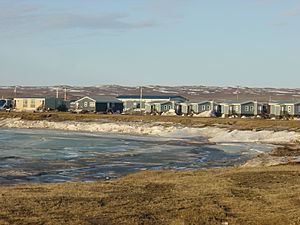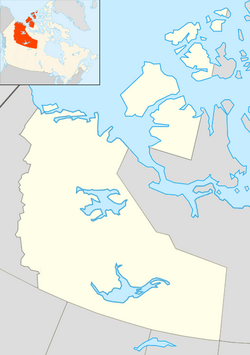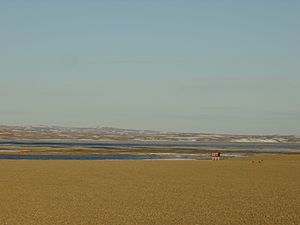Paulatuk facts for kids
Quick facts for kids
Paulatuk
Paulatuuq
|
|
|---|---|

The hamlet of Paulatuk in May
|
|
| Country | Canada |
| Territory | Northwest Territories |
| Region | Inuvik Region |
| Constituency | Nunakput |
| Census division | Region 1 |
| Incorporated (hamlet) | 1 April 1987 |
| Area | |
| • Land | 66.86 km2 (25.81 sq mi) |
| Elevation | 5 m (16 ft) |
| Population
(2021)
|
|
| • Total | 298 |
| • Density | 4.0/km2 (10/sq mi) |
| Time zone | UTC−07:00 (MS) |
| • Summer (DST) | UTC−06:00 (MDT) |
| Canadian Postal code |
X0E 1N0
|
| Area code(s) | 867 |
| Telephone exchange | 580 |
| - Living cost | 177.5 |
| - Food price index | 195.9 |
| Sources: Department of Municipal and Community Affairs, Prince of Wales Northern Heritage Centre, Canada Flight Supplement 2009 figure based on Edmonton = 100 2010 figure based on Yellowknife = 100 |
|
Paulatuk is a small community called a hamlet in the Northwest Territories, Canada. It is located right next to Darnley Bay in the Amundsen Gulf. The town got its name from the coal found in the area in the 1920s. In the Siglitun language, Paulatuuq means "place of coal."
People have lived in this area for a very long time, including the Thule and Copper Inuit, starting around 1000 CE. Today, Paulatuk is part of the Inuvialuit Settlement Region. It officially became a hamlet in 1987 and celebrated 50 years since its settlement in 2015.
| Top - 0-9 A B C D E F G H I J K L M N O P Q R S T U V W X Y Z |
People of Paulatuk
|
|||||||||||||||||||||||||||||||||||||||
|
||||||||||||||||||||||||||||||||||||||||||||||||||||||||||||||||||||||||||||||
In 2021, a count of people called the 2021 Canadian census, showed that Paulatuk had 298 people living there. This was a small increase from 265 people in 2016.
Most people in Paulatuk are Indigenous, specifically Inuit (Inuvialuit). The two main languages spoken are Inuinnaqtun (Inuvialuktun) and English.
Life in Paulatuk
European people started settling here when the Roman Catholic Church opened a trading post. In the 1950s, a special radar site called the Distant Early Warning Line was built nearby. This gave people in Paulatuk jobs and a way to earn money. The local store is now part of The North West Company.
Hunting, fishing, and trapping are very important ways of life and work here. In recent years, making art prints has also become a big part of the local economy.
The Smoking Hills are about 105 km (65 miles) west of Paulatuk, by the Arctic Ocean. They are interesting because they affect the water around them. East of the community is Tuktut Nogait National Park, and Parks Canada has an office in Paulatuk.
Amazing Artists and Leaders
Paulatuk is known for its talented Inuit artists. Their dance, music, sculptures, prints, and drawings are famous across Canada and even around the world.
Artists from Paulatuk
Floyd Kuptana
Floyd Kuptana was born in 1964. He learned from another artist, David Ruben Piqtoukun, and started making his own art in 1992. He is known for carving, sculpting, and painting.
Robert Kuptana
Robert Kuptana was born in 1962. He has been a carver since he was young. He learned from his brother Floyd and started working as a professional artist in 1998.
The Paulatuk Moonlight Dancers
The Paulatuk Moonlight Dancers are a group that performs traditional Inuvialuit dances. They have danced in Canada, the United States, Greenland, and Germany. Michael “Nolan” Green leads the group. He also served as a local council member and received a Canada Youth Award in 2002.
Abraham Anghik Ruben
Abraham Anghik Ruben was born near Paulatuk in 1951. He lived on the land with his family until he was eight years old. He now lives on Salt Spring Island.
His sculpture from 2001, The Last Goodbye, shows his and his brothers' experiences. They were separated from their family because of the residential school system. Ruben said:
I clearly remember when this took place—my mother sitting with my older brother and sister, David and Martha, just before they left for the Mission school in Aklavik. David was five years old at the time and Martha was only a little older. It was a scene that was repeated later on when my other brothers and I were sent off to residential school. But this time, it was sadder for my mother, because it would be three years that David and Martha would be gone. They left in 1955 and we didn’t see them again until the latter part of 1958. Those three years had a permanent impact on my brother’s life."
Ruben was given a special honour, becoming an Officer in the Order of Canada, in 2016. This was for his amazing sculptures and for helping to keep northern culture alive.
David Ruben Piqtoukun
David Ruben Piqtoukun was born in Paulatuk in 1950. He is a sculptor and print artist. He is also Abraham Anghik Ruben's brother and taught Floyd Kuptana.
Mayors of Paulatuk
A mayor has led Paulatuk since it became a hamlet in 1987. The first mayor was Garrett Ruben. He was also a community leader before Paulatuk became a hamlet. He worked to help the community and served as mayor for 24 years. Garrett Ruben passed away in 2007. His son, Ray Ruben, is now the sixth mayor of Paulatuk.
Other Important People
Anny Illasiak
Paulatuk elder Anny Illasiak, also known as Granny Uma, passed away in 2012 at 74. She lived in Paulatuk since the 1970s. Anny was a leader who taught children and young people how to live off the land. She also started a community sewing group, teaching others to make traditional clothes and creating beautiful tapestries herself. She volunteered as a cook for the Paulatuk Community Kitchen. For 10 years, she taught the Aboriginal language for the Paulatuk Aboriginal Headstart Program.
Elizabeth Kuptana
Elizabeth "Liz" Kuptana is a Paulatuk elder, teacher, and storyteller. She received the Wallace Goose Award for her selfless dedication to the Inuvialuit people. She teaches children and youth about Inuvialuit culture, language, and the history of the Inuvialuit Final Agreement. In 2013, she was awarded the Queen Elizabeth II Diamond Jubilee Medal.
The Paulatuuq Oral History Project
The book Paulatuuq Oral History Project: Elders Share Their Stories was published in 2004. Eight elders from the community shared their memories and stories for this book.
Community Services
Paulatuk has important services for its residents. These include:
- A Royal Canadian Mounted Police office with two officers.
- A health centre with two nurses.
- Phone services from Northwestel.
- Internet services from SSI Micro.
Children can go to school up to Grade 12 at the Angik School. There is also a community learning centre run by Aurora College.
Paulatuk cannot be reached by road. However, there is an airport, Paulatuk (Nora Aliqatchialuk Ruben) Airport. Aklak Air provides flights from Inuvik three times a week. In the summer, floatplanes can use the Paulatuk Water Aerodrome. Also, a yearly sealift brings supplies by boat from Hay River.
Paulatuk's Climate
Paulatuk has a subarctic climate. This means it has long, cold winters and short, cool summers. It almost has a tundra climate, but July's average temperature is just warm enough. There isn't a lot of rain, and it mostly falls from June to September. These are the only months when the average temperature stays above freezing.
| Climate data for Paulatuk (Nora Aliqatchialuk Ruben Airport), 1991–2020 normals, extremes 1985−present | |||||||||||||
|---|---|---|---|---|---|---|---|---|---|---|---|---|---|
| Month | Jan | Feb | Mar | Apr | May | Jun | Jul | Aug | Sep | Oct | Nov | Dec | Year |
| Record high humidex | 3.2 | 13.7 | −0.3 | 10.4 | 21.8 | 30.1 | 33.6 | 31.7 | 23.4 | 14.9 | 6.6 | 1.9 | 33.6 |
| Record high °C (°F) | 4.0 (39.2) |
−2.6 (27.3) |
1.4 (34.5) |
11.5 (52.7) |
23.1 (73.6) |
29.5 (85.1) |
30.2 (86.4) |
31.0 (87.8) |
20.7 (69.3) |
16.2 (61.2) |
7.6 (45.7) |
3.0 (37.4) |
31.0 (87.8) |
| Mean daily maximum °C (°F) | −21.0 (−5.8) |
−21.4 (−6.5) |
−18.9 (−2.0) |
−9.7 (14.5) |
1.1 (34.0) |
9.8 (49.6) |
14.2 (57.6) |
12.2 (54.0) |
6.0 (42.8) |
−2.7 (27.1) |
−12.2 (10.0) |
−18.8 (−1.8) |
−5.1 (22.8) |
| Daily mean °C (°F) | −24.7 (−12.5) |
−25.2 (−13.4) |
−23.3 (−9.9) |
−14.5 (5.9) |
−2.8 (27.0) |
5.6 (42.1) |
10.3 (50.5) |
9.0 (48.2) |
3.5 (38.3) |
−5.2 (22.6) |
−15.6 (3.9) |
−22.3 (−8.1) |
−8.8 (16.2) |
| Mean daily minimum °C (°F) | −28.3 (−18.9) |
−29.0 (−20.2) |
−27.6 (−17.7) |
−19.2 (−2.6) |
−6.6 (20.1) |
1.5 (34.7) |
6.4 (43.5) |
5.7 (42.3) |
0.9 (33.6) |
−7.6 (18.3) |
−18.8 (−1.8) |
−25.9 (−14.6) |
−12.4 (9.7) |
| Record low °C (°F) | −42.0 (−43.6) |
−44.1 (−47.4) |
−47.4 (−53.3) |
−36.8 (−34.2) |
−28.7 (−19.7) |
−6.2 (20.8) |
−2.0 (28.4) |
−3.2 (26.2) |
−11.0 (12.2) |
−34.1 (−29.4) |
−37.5 (−35.5) |
−42.6 (−44.7) |
−47.4 (−53.3) |
| Record low wind chill | −55.5 | −56.6 | −59.6 | −48.2 | −35.6 | −12.0 | −6.6 | −9.5 | −20.0 | −49.9 | −48.6 | −49.9 | −59.6 |
| Average precipitation mm (inches) | 14.2 (0.56) |
13.8 (0.54) |
16.8 (0.66) |
14.8 (0.58) |
12.9 (0.51) |
18.8 (0.74) |
25.2 (0.99) |
35.4 (1.39) |
25.0 (0.98) |
22.5 (0.89) |
15.1 (0.59) |
12.6 (0.50) |
227.0 (8.94) |
| Average rainfall mm (inches) | 0.0 (0.0) |
0.0 (0.0) |
0.0 (0.0) |
0.0 (0.0) |
3.1 (0.12) |
13.6 (0.54) |
21.9 (0.86) |
34.1 (1.34) |
18.7 (0.74) |
1.4 (0.06) |
0.1 (0.00) |
0.0 (0.0) |
92.9 (3.66) |
| Average snowfall cm (inches) | 14.2 (5.6) |
10.7 (4.2) |
15.5 (6.1) |
11.3 (4.4) |
11.5 (4.5) |
0.7 (0.3) |
0.0 (0.0) |
0.4 (0.2) |
6.1 (2.4) |
25.1 (9.9) |
19.3 (7.6) |
17.1 (6.7) |
131.8 (51.9) |
| Average precipitation days (≥ 0.2 mm) | 11.4 | 10.8 | 11.2 | 9.0 | 7.9 | 8.7 | 11.0 | 14.2 | 13.3 | 13.1 | 11.6 | 12.0 | 134.0 |
| Average rainy days (≥ 0.2 mm) | 0.0 | 0.0 | 0.0 | 0.0 | 1.4 | 6.3 | 8.6 | 12.9 | 8.4 | 0.8 | 0.1 | 0.0 | 38.4 |
| Average snowy days (≥ 0.2 cm) | 8.9 | 7.7 | 8.7 | 6.8 | 6.2 | 0.7 | 0.0 | 0.6 | 3.4 | 11.6 | 10.9 | 9.7 | 75.0 |
| Average relative humidity (%) (at 3pm) | 78.1 | 75.9 | 72.8 | 71.1 | 75.4 | 75.5 | 72.8 | 76.5 | 78.3 | 82.5 | 83.1 | 80.2 | 76.8 |
| Source: Environment Canada (rain/rain days, snow/snow days 1981–2010) | |||||||||||||




